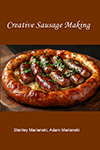Meats and Sausages
Morcón de Lorca
This is a traditional recipe for making Morcón de Lorca. Pork head and dewlap is used and the sausage is stuffed in pork bladder or stomach. As the name implies the sausage originates in the municipality of Lorca in Murcia region of Spain. Morcón de Lorca breaks with established rules for making morcón as practiced in Extremadura, Castilla-León and Andalusia and is made with different cuts of meat, without pimentón and is cooked.
| Meats | Metric | US |
|---|---|---|
| Pork head meat and dewlap | 1000 g | 2.2 lb |
Ingredients per 1000g (1 kg) of meat
| Salt | 20 g | 2.5 tsp |
| White pepper | 4.0 g | 2 tsp |
| Aniseed, ground | 0.3 g | 1.8 tsp |
| Cinnamon | 1.0 g | 1.2 tsp |
| Nutmeg | 0.5 g | 1/4 tsp |
| Cloves | 0.3 g | 1/8 tsp |
| Egg | 1 | 1 |
Instructions
- Cook split heads and dewlaps in water at 95° C (203° F) until meat can be separated from bones. Drain and spread on the table. Cool until comfortable to handle; separate meat from bones.
- Cut or grind meats into 12 mm (1/2”) pieces.
- Mix meats with salt, spices and beaten egg.
- Stuff into pork bladders or stomachs.
- Cook in water at 80° C (176° F) for about 150 minutes or until the sausage reaches 72° C (160° F) internal temperature.
- Refrigerate.
Notes
This is a large sausage, about 15 cm (6”) in diameter if stuffed in bladders.
The sausage can be kept at cool temperature and low humidity for 30-45 days. It was customary to store the sausage covered with oil and pimentón.
The texture of the sausage looks much better if meat is cut manually.
In order to be red the meat needs to be cured with sodium nitrite (cure #1). Some raw head meat can be carved with knife and dry cured with cure#1 for 2 days, such meat will be red after cooking in water. The split head can be cooked in water, but the cooked meat will be grey. The whole split head could be cured in wet curing solution (water, salt, cure #1) and then cooked in water, but this solution is more practical for commercial producers.
The sausage can be kept at cool temperature and low humidity for 30-45 days. It was customary to store the sausage covered with oil and pimentón.
The texture of the sausage looks much better if meat is cut manually.
In order to be red the meat needs to be cured with sodium nitrite (cure #1). Some raw head meat can be carved with knife and dry cured with cure#1 for 2 days, such meat will be red after cooking in water. The split head can be cooked in water, but the cooked meat will be grey. The whole split head could be cured in wet curing solution (water, salt, cure #1) and then cooked in water, but this solution is more practical for commercial producers.

















